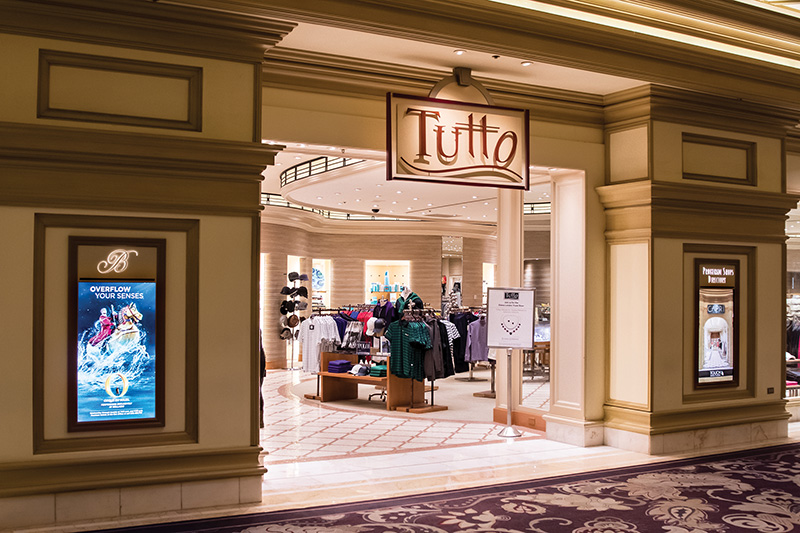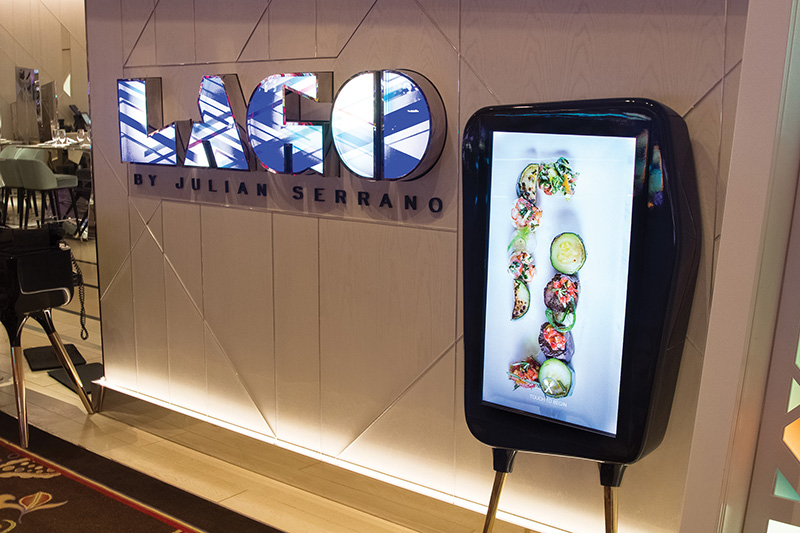MGM Resorts International: A case study in digital signage deployment.
By Randy Dearborn
We run one of the largest digital signage networks that happens to encompass several different verticals, which include entertainment, gaming, hotel, convention and meeting facilities along with two that are the focus for this article: restaurants and retail space. MGM Resorts’ current Las Vegas portfolio includes over 350 restaurants along with more than 450 retail outlets that are frequented by many of the 42 million visitors who arrive in Las Vegas on an annual basis.
Running multiple venues in an environment of sensory overload, we were one of the first to begin converting static printed menu boards — that you typically see outside restaurants — to digital touchscreens. Initially they were simple menus showing item, description and price, along with a few tasty images, which were meant to stimulate interaction and draw customers in to that particular outlet. Fast forward several years and today these screens have become fully interactive experiences that track data from every interaction along with the ability to dynamically create offers, change pricing and push social feeds through an operator controlled interactive browser.
 However, it is important to step back to the genesis of our approach and see how we methodically laid out our strategy.
However, it is important to step back to the genesis of our approach and see how we methodically laid out our strategy.
Our first interactive touch screen was wire-framed, developed and deployed in early 2004 at Bellagio. We learned several key lessons that still hold true today. First, it’s important to come to an internal consensus on the purpose of the screen. If you receive blank stares from operations when you first ask, “What is the primary goal of this deployment?” there is no compelling reason for the investment. Conversely, if the group is unfocused and “wants it to do everything,” the project is doomed without focus. The best course is to lay out a simple, straightforward purpose such as: show captivating images, push last-minute specials, yield revenue through dynamic pricing, enhance customer communication with social engagement, and so on.
The first two examples are fairly easy rollouts, but initiating dynamic pricing can be a challenge. In a quick-serve location where pricing is only shown on one (or only a few) digital menu boards, you can develop a software hook (API) into the POS (point of sales) or create a separate pricing scheduling interface. This means prices must change or be set up on a predetermined pricing tier for both systems at the same time. We did this for years awaiting POS software upgrades. But, if applied to a traditional restaurant with printed menus distributed to customers, pricing is limited to specials or going all-in and converting every menu on to digital tablets. Also remember that pricing must also be updated on the website for any of these applications. Dynamic pricing gets complicated very quickly, which is why buffets work the best — no menus.
The social engagement can be incredibly rewarding or overwhelming if no rules are set from the start. We did a Twitter screen for one of our Starbucks outlets a few years ago and the first thing I asked them was what they were trying to achieve. The response was solely “awareness and interaction,” precluding upsell, specials or coffee promotions. Because people already know what they are ordering when they walk into a Starbucks, that answer made perfect sense. The video wall has been such a hit they asked my group to do more, but at the time we didn’t have the manpower and did not want to involve legal in lengthy negotiations. Other invaluable lessons we learned were, get operational buy in — you can create the coolest thing out there but if the operator can’t understand it, doesn’t have the patience or staff to operate it, or refuses to embrace it, your application will die a horrible death.
I’ve had this happen a few times, most recently with digital wine menus designed for tablets. We rolled out 35 different venues with no centralized training program and we got 35 different results. The outlets that embraced the program and utilized it as a sales tool have worked out well and continue to use it. The outlets that threw the tablets on the table and walked away have now gone back to a printed wine list. Although there is a silver lining, we have since regrouped with several of those operators and have developed a much simpler appetizer and drink menu on the same tablets that need minimal interaction from the staff. If you plan on doing several venues that are not cookie-cutter outlets, standardize your navigation and nomenclature; it really helps on the development side of things.
 Another thing I always preach is do what you do best and outsource to others what they do best. We are a unique shop because we create, control, install and maintain the hardware, software and content for our ecosystem. But now I leverage several vendors to develop or maintain some of our systems. This allows us to really move more quickly on certain projects we feel we do better than anyone else.
Another thing I always preach is do what you do best and outsource to others what they do best. We are a unique shop because we create, control, install and maintain the hardware, software and content for our ecosystem. But now I leverage several vendors to develop or maintain some of our systems. This allows us to really move more quickly on certain projects we feel we do better than anyone else.
Our retail experiences runs parallel to several of the earlier comments with one major exception. I find retailers much easier to work with and more willing to try different tactics, such as promoting blanket discount offers across specific items or multiple items. Remember, if you promote 25% off all leather goods, you don’t have to change price tags and it’s easy to adjust in your POS. If you run 25% off all fish dishes in a restaurant, no one will order the fish because they are probably wondering what’s wrong with it.
Candidly, my involvement in Digital Signage Expo and the Digital Signage Federation really opened my eyes and I can’t say enough about how much these organizations have broadened my horizons. As I mentioned earlier we operate a wide range of both restaurant and retail venues, which cover every price point. Our portfolio at MGM Resorts includes Circus-Circus, Bellagio and everything in between. In spite of having such a wide range of offerings we were treating all audiences the same. That is why, when I became involved with DSE and DSF, and was exposed in great detail to how a high-end retailer utilized a completely different approach than a souvenir shop through their digital signage platform, it compelled me to adjust and leverage my existing ecosystem to recognize the differences between those audiences.
And no, I’m not so naïve not to know the difference between a Gucci handbag and a coffee mug, but we were treating our digital signage as just selling stuff. Come to think of it, maybe I was naïve.
INSIDE THE DIGITAL SIGNAGE FEDERATION
The Digital Signage Federation® is a not-for-profit independent voice of the digital signage industry reflecting the diversity of its membership. It promotes professional recognition through certifications, continuing education, conferences, publications and presentations offered by the DSF® and affiliate groups. For more information, visit www.digitalsignagefederation.org.
— Randy Dearborn is the 2016 chairman of the Digital Signage Federation and vice president of media technology for MGM Resorts International, one of the world’s leading hotel and gaming companies headquartered in Las Vegas. Dearborn has been with MGM for 23 years and has played an instrumental role in the development, deployment and support of one of the largest digital media platforms in the industry, which encompasses content, hardware and software. His previous work experience includes Disney, Four Seasons and Marriott.
